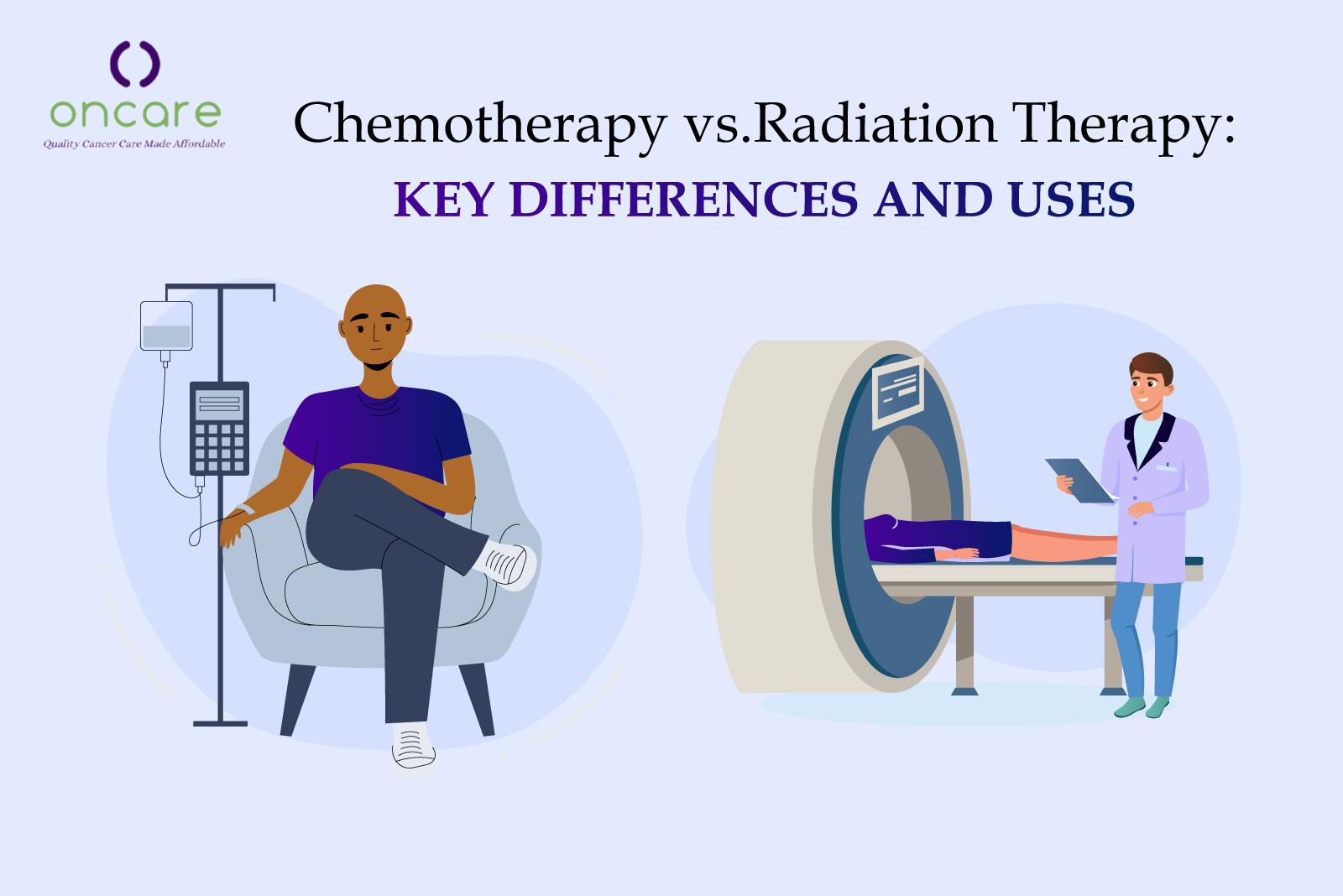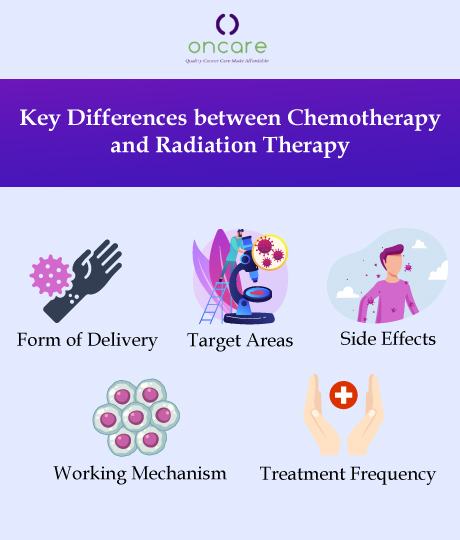Chemotherapy vs. Radiation Therapy: Key Differences and Uses

Chronic health conditions can impose a lot of risk for the concerned individuals. To nurture suffering patients back to good health, the medical sector has come up with a broad spectrum of treatments for severe maladies. In particular, chemotherapy and ration therapy are two of the popular treatment options available for ailing patients to fight against the rapidly spreading cancer cells. Although these treatments are used widely, patients still lack clarity about the specific uses and side effects of these therapies. In this article, we explore the significant uses of each of these procedures to better understand chemotherapy vs radiation therapy.
Table Of Content :
- Understanding the goals of chemotherapy
- Understanding the goals of radiation therapy
- Side effects associated with chemotherapy and radiation therapy
- Key differences between chemotherapy and radiation therapy
- Conclusion
- FAQs
Understanding the goals of chemotherapy
Chemotherapy, regularly called "chemo," entails the usage of powerful medications to annihilate cancer cells. Its sole aim is to decrease tumors, impede the spreading of cancers, and, in the long run, get rid of cancerous cells entirely from the body. This therapy can be delivered in a variety of methods. These involve applying creams, taking oral medications, delivering liquid drugs intravenously by infusion, etc. This therapy influences your entire body. Your oncologist will conduct several clinical tests before advising you on this treatment. Moreover, to enhance its effectiveness, oncologists combine this therapy with other available methods, such as surgery or radiation therapy, depending on the patient's condition. For instance, your oncologist may advise chemo before performing an operation surgery to remove tumors in the affected location of your body. Let's see the uses of chemo to better understand chemotherapy vs radiation therapy.
- It is used to disrupt cell division and hinder their growth.
- This therapy kills cancerous cells and prevents the probability of relapse.
- This treatment is employed to reduce the size of the tumor before surgery.
- In end-stage cancer, this therapy is deployed to ease the symptoms and alleviate pain.
Read More : What is Chemotherapy? (+ Types & How They Work)
Understanding the goals of radiation therapy
This treatment is medically also referred to as radiotherapy. In this, intensive radiation beams are deployed for targeted extermination of the cancerous cells's DNA. This obstructs the cells from expanding and spreading in other locations of your body. Radiation therapy can be provided in two ways, which is a distinctive factor in answering the question, “is chemotherapy and radiation the same thing". The implementation method of this treatment can depend on the cancer type, the area of the tumor formed by cancerous cells, and so on. This treatment is employed externally using radiation from X-rays or protons to hinder the growth of cancer-causing cells and eliminate them. In internal radiotherapy, using high imaging technology, the oncologists will implant radioactive wires, tubes, ribbons, steel seeds, etc., to target specific locations. Moreover, oral liquids, injections, and infusion methods are also used to halt the cancer growth in this procedure. To better understand chemotherapy vs radiation therapy, the uses of radiotherapy are briefly listed below.
- It halts the cells from growing further in your body either by using external means or via internal methods.
- As a neoadjuvant therapy, this procedure shrinks the size of the tumor before a surgical operation.
- This treatment is deployed as adjuvant therapy to kill the lingering cancerous cells.
- In the last stages of cancer, this treatment can minimize the impact of the symptoms and discomfort.
Read More : Understanding Radiation Therapy: What It Is and How It Works
Side effects associated with chemotherapy and radiation therapy
Understanding chemotherapy vs radiation therapy requires knowing about the mild to severe adverse effects of both these treatments. In chemotherapy, the incorporated drugs may destroy healthy tissues while trying to eliminate the cancerous cells. In addition to the site of cancer, other areas of your body may also be affected. Likewise, in internal radiotherapy, the surrounding healthy cells are also damaged along with targeted carcinogenic cells in specific areas. The general aftereffects of chemo and radiotherapy are listed below to apprehend the topic “is chemotherapy and radiation the same thing”.
- Red and itching skin and swollen areas
- Memory loss
- Hair fall
- Constipation
- Insomnia
- Fever
- Headaches
- Nausea
- Increased urination
- Throat pain
- Cracking and darkening of nails, etc
Read More : Common Side Effects of Chemotherapy You Should Know About
Key differences between chemotherapy and radiation therapy
With the advanced techniques employed by seasoned oncologists from reputed medical facilities like Oncare Cancer, a lot of adverse effects of chemo and radiotherapy can be mitigated. If you or anyone you know is battling against cancer, it is indispensable that you understand your available treatment options. Stated below are some parameters emphasizing diff between chemo and radiation treatments.
Working mechanism
Chemotherapy is mostly deployed to inhibit the cell multiplication in your body and kill the carcinogenic cells eventually. Radiotherapy, on the other hand, targets cancerous cells to kill them by impairing the cell DNA. Both treatments can be used individually or alongside other available procedures.
Target areas
Another element that explains the diff between chemo and radiation is the area of therapy. In the chemo procedure, the drugs are deployed to locate and exterminate cancerous cells in the entire body. Radiation therapy, in contrast, aims at specific regions in the body to eliminate the cells and hinder their growth by debilitating the DNA.
Form of delivery
In the case of chemo, cell-killing drugs in the form of capsules or liquids are given to patients either orally or intravenously by infusion. Radiotherapy entails intense beams from X-rays, protons or gamma rays. The radiation from these beams is delivered in internal, external or systemic forms formulated in seeds, wires, ribbons, liquids, etc.
Side effects
Side effects vary in chemotherapy vs radiation therapy. As beams of radiation are deployed in radiotherapy, the generally occurring aftereffects are red and dry skin, discomfort in the targeted areas, tiredness, and so on. Meanwhile, chemotherapy encompasses hair loss, lower blood cells, nausea, etc. As the focused areas are specific in radiotherapy, the adverse effects in this process are lower when compared to chemotreatment.
Treatment Frequency
How often you need each treatment is a significant element to be noted to answer the question, “is chemotherapy and radiation the same thing”. Radiation therapy lasts from a few days to weeks, and the procedure is performed daily. Chemotherapy, in contrast, has intervals for resting between the sessions, which may last from weeks to months.

Conclusion
Although both chemo and radiation therapy have their distinctive merits, knowing which treatment to seek when is indispensable. As highlighted above, chemotherapy vs radiation therapy has salient differences and a few similarities. If you think you might need any of these treatments, it is essential to opt for a reliable and accredited medical facility. Expert oncologists at Oncare Cancer are proficient in providing staunch therapies to ensure patient well-being and have over 15+ years of experience in rendering successful cancer treatments.
Frequently Asked Questions (FAQs)
The main differences in chemotherapy vs radiation therapy are the areas of treatment, associated side effects, delivery mechanism, frequency of treatment, etc. Additionally, the drugs and prescriptions deployed also vary between these therapies.
The working of chemotherapy vs radiation therapy for cancer differs in several ways. Chemotherapy involves the entire body to locate and kill harmful cancer cells, while radiotherapy entails targeting only the affected areas.
In chemotherapy vs radiation therapy for cancer, both treatments can be effective, and their uses depend on the patient's condition. Radiation therapy is more effective in location-specific treatments involving the chest, eyes, breasts, etc. Chemotherapy, conversely, is used for rapidly spreading cancers like testicular cancers.
Chemotherapy has aftereffects like hair loss, brain fog, nausea, reduced count of blood cells, etc due to damage to healthy tissues. The side effects of radiotherapy are mostly dry, itching, and swollen skin, discomfort in treated areas, fatigue, etc.
When one therapy does not provide the desired results, it is used in combination with other available treatments. Both chemotherapy and radiation therapy are used individually, in combination or integrated with other available treatments based on cancer type and stage.